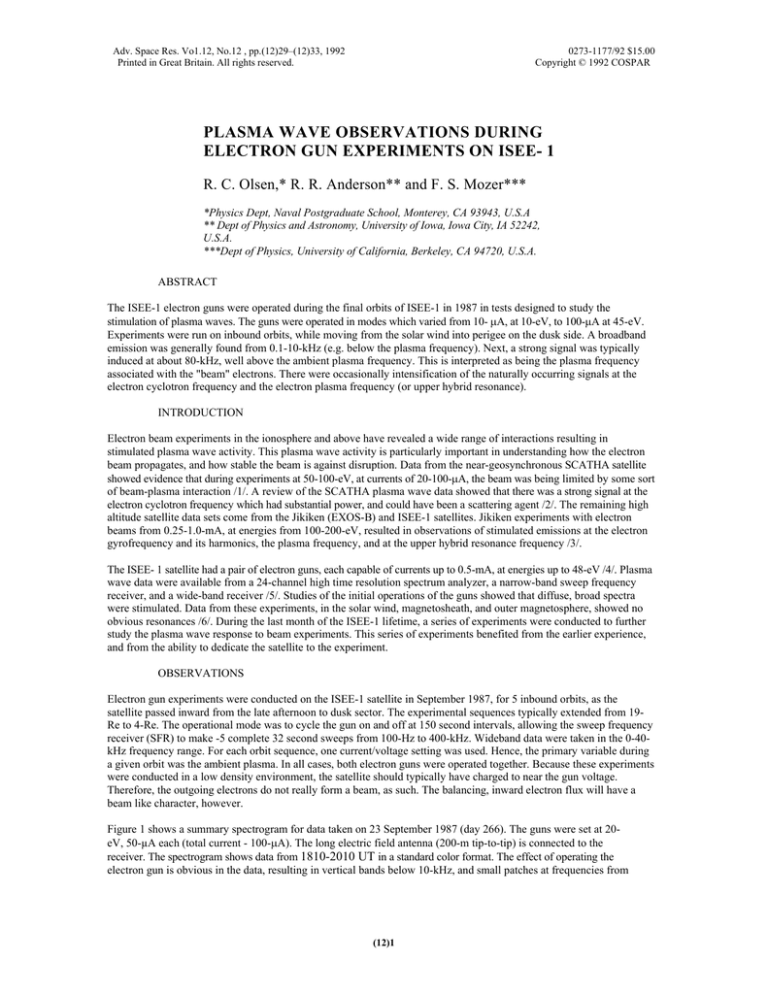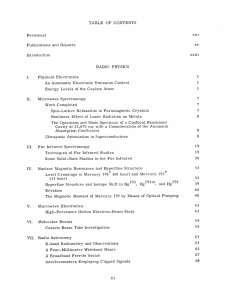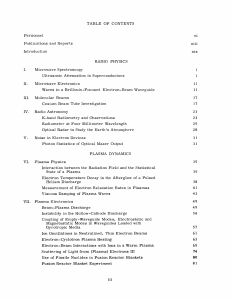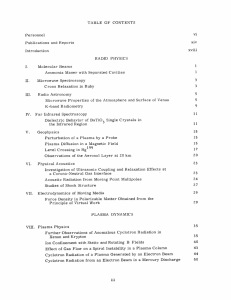Document 11781035
advertisement

Adv. Space Res. Vo1.12, No.12 , pp.(12)29–(12)33, 1992 Printed in Great Britain. All rights reserved. 0273-1177/92 $15.00 Copyright © 1992 COSPAR PLASMA WAVE OBSERVATIONS DURING ELECTRON GUN EXPERIMENTS ON ISEE- 1 R. C. Olsen,* R. R. Anderson** and F. S. Mozer*** *Physics Dept, Naval Postgraduate School, Monterey, CA 93943, U.S.A ** Dept of Physics and Astronomy, University of Iowa, Iowa City, IA 52242, U.S.A. ***Dept of Physics, University of California, Berkeley, CA 94720, U.S.A. ABSTRACT The ISEE-1 electron guns were operated during the final orbits of ISEE-1 in 1987 in tests designed to study the stimulation of plasma waves. The guns were operated in modes which varied from 10- µA, at 10-eV, to 100-µA at 45-eV. Experiments were run on inbound orbits, while moving from the solar wind into perigee on the dusk side. A broadband emission was generally found from 0.1-10-kHz (e.g. below the plasma frequency). Next, a strong signal was typically induced at about 80-kHz, well above the ambient plasma frequency. This is interpreted as being the plasma frequency associated with the "beam" electrons. There were occasionally intensification of the naturally occurring signals at the electron cyclotron frequency and the electron plasma frequency (or upper hybrid resonance). INTRODUCTION Electron beam experiments in the ionosphere and above have revealed a wide range of interactions resulting in stimulated plasma wave activity. This plasma wave activity is particularly important in understanding how the electron beam propagates, and how stable the beam is against disruption. Data from the near-geosynchronous SCATHA satellite showed evidence that during experiments at 50-100-eV, at currents of 20-100-µA, the beam was being limited by some sort of beam-plasma interaction /1/. A review of the SCATHA plasma wave data showed that there was a strong signal at the electron cyclotron frequency which had substantial power, and could have been a scattering agent /2/. The remaining high altitude satellite data sets come from the Jikiken (EXOS-B) and ISEE-1 satellites. Jikiken experiments with electron beams from 0.25-1.0-mA, at energies from 100-200-eV, resulted in observations of stimulated emissions at the electron gyrofrequency and its harmonics, the plasma frequency, and at the upper hybrid resonance frequency /3/. The ISEE- 1 satellite had a pair of electron guns, each capable of currents up to 0.5-mA, at energies up to 48-eV /4/. Plasma wave data were available from a 24-channel high time resolution spectrum analyzer, a narrow-band sweep frequency receiver, and a wide-band receiver /5/. Studies of the initial operations of the guns showed that diffuse, broad spectra were stimulated. Data from these experiments, in the solar wind, magnetosheath, and outer magnetosphere, showed no obvious resonances /6/. During the last month of the ISEE-1 lifetime, a series of experiments were conducted to further study the plasma wave response to beam experiments. This series of experiments benefited from the earlier experience, and from the ability to dedicate the satellite to the experiment. OBSERVATIONS Electron gun experiments were conducted on the ISEE-1 satellite in September 1987, for 5 inbound orbits, as the satellite passed inward from the late afternoon to dusk sector. The experimental sequences typically extended from 19Re to 4-Re. The operational mode was to cycle the gun on and off at 150 second intervals, allowing the sweep frequency receiver (SFR) to make -5 complete 32 second sweeps from 100-Hz to 400-kHz. Wideband data were taken in the 0-40kHz frequency range. For each orbit sequence, one current/voltage setting was used. Hence, the primary variable during a given orbit was the ambient plasma. In all cases, both electron guns were operated together. Because these experiments were conducted in a low density environment, the satellite should typically have charged to near the gun voltage. Therefore, the outgoing electrons do not really form a beam, as such. The balancing, inward electron flux will have a beam like character, however. Figure 1 shows a summary spectrogram for data taken on 23 September 1987 (day 266). The guns were set at 20eV, 50-µA each (total current - 100-µA). The long electric field antenna (200-m tip-to-tip) is connected to the receiver. The spectrogram shows data from 1810-2010 UT in a standard color format. The effect of operating the electron gun is obvious in the data, resulting in vertical bands below 10-kHz, and small patches at frequencies from (12)1 (12) 2 R. C. Olsen et. al. 60-90-kHz. The major ambient features of interest here are the discrete emission at the upper hybrid resonance frequency, and the electron cyclotron harmonics. Plasmaspheric hiss dominates the lower frequency portion of the spectrum /5/. The upper hybrid signal starts at about 15-kHz at 1810 UT, and rises monotonically in frequency, as the satellite moves in through the dusk bulge region of the plasmasphere. The upper hybrid reaches 60-kHz at 2010 UT. The electron cyclotron harmonics (n+ ½ ) are visible below the upper hybrid, and above the gun induced broad-band spectrum. The dark spots occurring regularly from 60-90-kHz are a persistent feature of the experiments conducted at this current/energy setting (days 262 and 266). The frequency at which the noise peaks drops over the experimental period. The signal is at 85-kHz at 1640 UT (data not shown). At 1900 UT, the frequency is 75-kHz. By 1927 UT, the frequency has dropped to about 650kHz. Both the ambient plasma density and the magnetic field strength have changed over this interval. Assuming that these signals are related to the density of the electrons in the beam, it seems reasonable to compare the change in frequency to the change in the ambient plasma density. For the measurement (1640 UT) at 10-Re altitude, the continuum cutoff is -8-kHz. In the latter period, the plasma frequency has increased from 24-kHz (1900 UT) to 29-kHz (1927 UT). If the signal at 60-90-kHz is due to the density of the electrons produced by the electron gun, this could reflect an increase in beam-neutralizing currents from the ambient plasma, and a drop in the induced (positive) satellite potential. This would increase the velocity of the escaping electrons, reducing the density in the beam. The signals from 60-90 kHz have a harmonic at twice the frequency of the fundamental. This is visible in Figure 1 from 1830 to 1920 UT. Earlier on day 266, there is an odd sub-harmonic, at one-third the frequency. There is a fluctuation in frequency apparent here, resulting from a spin-modulation of the frequency of the signal, beating against the SFR cycle period (3-s vs 32-s). This is clearer in the spectrum analyzer data for this period and in the wideband data. During the period when the peak signal is at -85-kHz, the wideband data shows a sharp peak at frequencies which varies from 25-30-kHz. The modulation occurs once per spin. This modulation is most probably associated with the angle between the electron guns and the satellite-sun line, but could be the result of changing magnetic aspect. Figure 2 shows data with a different character from 7 September 1987 (day 250), for the period 0130-0330 UT. The current is still 50-µA in each gun, but the energy is 45-eV (the higher velocity gives a lower density in the beam). The broad, low frequency spectrum is seen again. In addition, there is a broad peak at 40-50-kHz outside L=8 (n < 5 /cm3). As the satellite moves inward, there are intermittent enhancements in the signal at the upper hybrid resonance frequency. Figure 3 shows wideband data from 0135-0148 UT for day 250. The vertical frequency axis ranges from 0-50-kHz, though the wideband data roll-off at about 40-kHz. At the left side of the figure, the gun is on, and there is a spin modulated signal from 4050-kHz, as in the SFR spectrogram. The gun cycles off, and the ambient plasma frequency becomes visible at 15-18-kHz. Below the plasma frequency are electron cyclotron harmonics. The plasma frequency increases sharply, and then the gun cycles on. The clear plasma frequency signal is replaced with narrow emissions near the plasma frequency. (The dotted pattern is due to a processing artifact.) From 0141-0142 UT, it is apparent that there is a strong line near the ambient plasma frequency, and two emission lines above and below the main line. The spacing is apparently equal to the electron cyclotron frequency (–3.3-kHz). Near 0147 UT, there are indications that the induced signal remains near 35-kHz, even as the ambient plasma frequency signal has dropped to 25-kHz. One further induced phenomenon was observed on 19 September 1987 (day 262). Signals were induced at or near the electron cyclotron frequency (–6-kHz), inside the plasmapause region, with a corresponding plasma frequency of 31-kHz. (Data not shown here.) SUMMARY AND CONCLUSIONS Plasma wave observations from experiments with the ISEE-1 electron gun have indicated that the gun stimulated plasma wave modes associated with the plasma density and electron gyrofrequency. A resonance associated with the gun parameters is observed above the ambient plasma frequency, perhaps depending on the density of the electrons in the beam and is most probably Langmuir waves within the electron beam. Since the satellite generally charged to near the beam energy, the electrons from the gun will generally be trapped near the satellite. The observed interactions must be fairly localized. (12) 3 R. C. Olsen et. al. Fig. 1. ISEE-1 data from the sweep frequency receiver, presented in spectrogram format. The intensity is color coded, per the color bar on the right hand side of the figure. These are data from 23 September 1987 (day 266). Fig. 2. ISEE-1 data from 7 September 1987 (day 250). Plasma Wave Observations (12)33 REFERENCES 1. Olsen, R. C., Electron beam experiments at high altitudes, J, Electrost, 20, 43-57 (1987). 2. Olsen, R. C., D. R. Lowery, and J. L. Roeder, Plasma wave observations during electron beam experiments at high altitudes, J. Geophys. Res., 94, 17267 (1989). 3. Kawashima, N., A. Ushikoshi, Y. Murasato, A. Morioka, H. Oya, M. Ejiri, S. Miyatake, and H. Matsumoto, Beam-plasma interaction experiment in the magnetosphere by emitting an electron beam from satellite Jikiken (EXOS-B), J. Geomagn. Geoelectr., 33, 145-159 (1981). 4. Pedersen, A., Plasma diagnostics by electron guns and electric field probes on ISEE-1, in Artificial Particle Beams in Space Plasma Studies, edited by B. Grandal, 121-132, Plenum, NY (1982). 5. Gurnett, D. A., R. R. Anderson, F. L. Scarf, R. W. Fredericks, and E. J. Smith, Initial results from the ISEE-1 and -2 plasma wave investigation, Space Sci. Rev,, 23, 103-122 (1979). 6. Lebreton, J.-P., R. Torbert, R. Anderson, and C. Harvey, Stimulation of plasma waves by electron guns on the ISEE-1 satellite, in Artificial Particle Beams in Space Plasma Studies, edited by B. Grandal, 133-146, Plenum, NY (1982). Fig. 3. Wideband data from ISEE-1 on 7 September 1987 (day 250) are shown in spectrogram form. Fifteen minutes of data are displayed, showing three on/off cycles with the electron guns. The electron guns are operating at 45 eV, with a total of 100 µA emitted. High amplitude signals are plotted as black against a white background.




